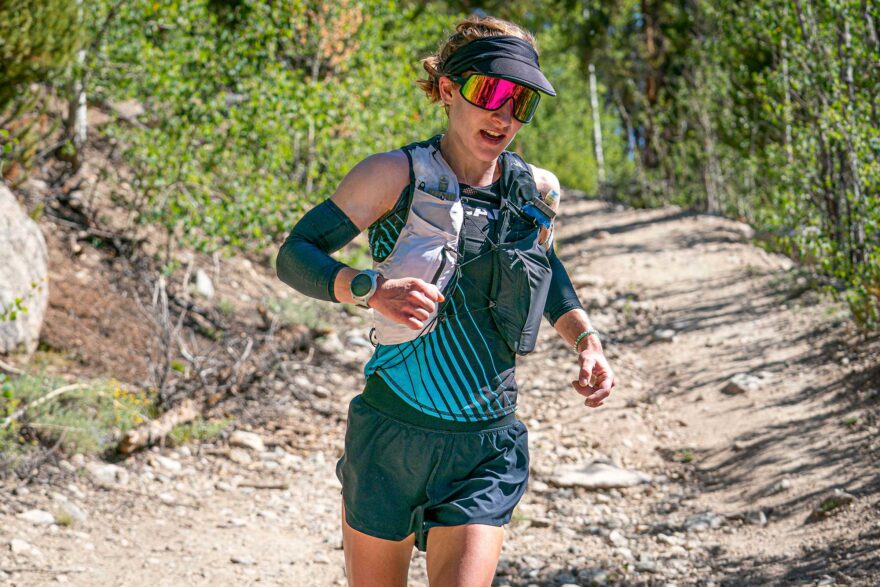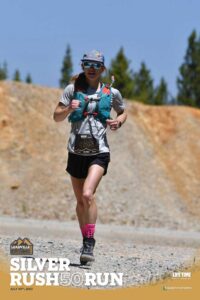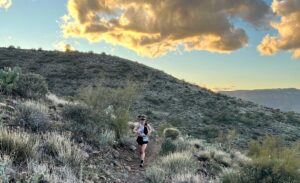
Leadville 100 (Image courtesy of Peter Maskimow)
Ultrarunning is having a moment — and for good reason. There’s no faster track to accessing the deepest parts of your body, mind, and soul than an inconceivably long foot-powered journey that takes you off the beaten path in more ways than one. It takes courage to stand on the start line of an ultramarathon because the process will inevitably create a potent mixture of physical and mental exhaustion that reveals your truest self. Whether you like what you find or not, it’s worth getting to know a version of you that might not appear under any other circumstances.
That being said, running an ultra is an undertaking. The preparation, the execution, and the recovery from an ultramarathon each eat up an enormous amount of energy. You can only dig that deep so often. Signing up for ultras with the same reckless abandon that you would for every local 5k will almost inevitably spark a dumpster fire full of chronic injury and fatigue. For the sake of your longevity in running, it pays to be prudent.
Ultrarunners who respect the demands of the sport and the limitations of their bodies would do well to choose their races wisely. But as ultrarunning continues to grow, there’s an exponentially increasing number of options to choose from … which only makes plotting out a race calendar all the more challenging. While it’s hard to go wrong, there are a few key races out there that have earned a reputation for creating an especially valuable experience for reasons ranging from breathtaking scenery to fierce competition to an electric environment.
Take the word of a professional trail runner for the best ultras of the bunch. The races on this list make ideal entry points into each distance. They all offer a wealth of support from dedicated race directors, benevolent volunteers, and enthusiastic spectators. The big energy makes any of them a solid choice for first-time experiences because you’re never too far from a helping hand or much-needed word of encouragement as you navigate the unknowns that come with bumping up to the next tier of distance. Runners can go in with confidence that, no matter what may happen out there, they have a stronger chance of finishing because of how much aid they can access along the course. The same aspect makes these events perfect for competitive racers as well.
Leave the logistics to the ever-accommodating RDs and accessible crew points so you can funnel all your focus into finding out just how deep your tank really is. Here are my picks for the ones in the Western U.S. that stand out for their accessibility (Eastern ultras will come later!):
50k
Desert Rats 50k: Loma, Colorado — April
Elevation gain: 3,400 feet
I’m lucky enough to call these my home trails, so trust me when I say that this course highlights the best of desert running. You get an exciting combination of fast, flowy singletrack and scrambly slickrock with striking red buttes rising in the distance everywhere you turn. The most harrowing sections send you scurrying over steep cliffs and winding your way through tight boulder passes — so you might have to remind yourself to look up at the view every once in a while! Let this April race give you a taste of techy speed to kick off your summer racing season.
Way Too Cool 50k: Cool, California — March
Elevation gain: 4,839 feet
Any race that offers a signature cupcake upon crossing the finish line is worth running in my book, but the Way Too Cool 50k has plenty to offer for the not-so-food-motivated as well (if any runners like that actually exist). There’s a little bit of everything that makes ultrarunning what it is: technical singletrack, comfy service roads, river crossings, steep climbs, and scenery so epic you’ll struggle to keep your eyes on the trail. This is many a newbie’s first foray into ultra running, and most make their way back for at least one repeat appearance!
Broken Arrow 46k: Tahoe, California — June
Elevation gain: 9,100 feet
Skyrunning is its own beast, but it’s worth the grueling climb to the height of Palisade Tahoe. Runners rack up over 9,000 feet of vertical gain throughout the Broken Arrow 46k and spend the majority of their time well above treeline. You’ll earn the heck out of some truly incredible views and traverse some of the same mountain passes of the famous Western States 100, so you can envision the day that the lottery finally works in your favor.

Silver Rush 50 (Image courtesy of Marathon Photos)
50 Mile
Arches 50: Moab, Utah — January
Elevation gain: 4,038 feet
If you’ve never been to Arches National Park, you’re in for a treat. And even if you have, there’s something different about experiencing it at a fast pace. Running through the canyons means you get to breathe easy at lower elevations while soaking in the sight of Moab’s iconic arches and cliffs rising up all around you. All the treat, none of the trick. There’s nothing easy about covering 50 trail miles in a single push, of course, but this one involves relatively little elevation gain so you can focus more on your surroundings than your quivering quads.
Silver Rush 50: Leadville, Colorado — July
Elevation gain: 7,184 feet
For the exact opposite experience, head up to lofty Leadville to spend some time gasping for air with your head in the clouds — literally and figuratively. Consider the Silver Rush 50 a taste-test for the legendary Race Across the Sky. This race actually includes more elevation gain per mile than the Leadville 100 itself, which means that if you can handle this race…well, you might as well put your name in the lottery now, because there’s zero chance you’ll want to stop there. Old mining roads mixed with a hint of singletrack topping out at 12,000+ feet above sea level makes the Silver Rush 50 fast, fluid, and exhilarating all at once. The Leadville community also comes out just as strong for the 50 as it does for the 100, and there’s no match for the team spirit of this high mountain town.
Lake Sonoma 50: Lake Sonoma, California — April
Elevation gain: 10,500 feet
A quick glance at the elevation profile of this race makes it seem much more tame than reality will prove. The climbs might be chill in isolation but man, do they add up. Good thing you’ll probably forget all about the struggle as soon as you look down at the lake you’re encircling and start to wonder if you’ve ever seen such green grass in your entire life. It starts and finishes with a few road miles so you can bookend the rollercoaster ride with a little speed.

Black Canyon 100k (Image courtesy of Lina Simpson)
100k
Black Canyon 100k: Mayer, Arizona — February
Elevation gain: 5,578 feet
This race will teach you a serious lesson about pacing strategy too, since the hype around the Black Canyon Ultras makes it hard to stay loose and save juice. The leader group takes off right out of the gate at a frighteningly fast past and continues in that manner for the first 30 miles. That’s because this rock-hop of a race begins with a net downhill charge over a combination of gentle dirt and increasingly technical singletrack. The second half becomes much more aggressive, with two abrupt climbs that sneak up on your already wrecked legs. But one look at the swaths of cacti as far as the eye can see and you’ll catch a second wind. Just don’t go running into their deceivingly welcoming arms.
Gorge Waterfalls 100k: Columbia River Gorge National Scenic Area, Oregon — April
Elevation gain: 11,000 feet
The name doesn’t lie. This is your chance to run through the Pacific Northwest’s most spectacular scenery (and sneak in a shower while you’re at it, whether you like it or not). Splish-splash along the river on semi-technical singletrack that will leave you feeling a little gripped as the gorge plummets down around you. Don’t underestimate the importance of keep on your toes …but you won’t want to miss a second of this absolutely gorge-eous course in the first place, so the motivation to stay alert comes two-fold.
Never Summer 100k: Gould, Colorado — July
Elevation gain: 14,450 feet
Never Summer promises runners a true alpine experience, and it doesn’t disappoint. You’ll spend the majority of your miles above 10,000 feet, cresting two peaks and passing four alpine lakes as you travel everything from dirt to gravel to rocky ridge and maybe even some snow for a hint of Christmas in July. Never Summer might offer one of the most challenging, mountainous 100k courses out there, but that’s balanced out by liberal time cutoffs that give most anyone with the determination to keep forging ahead the chance to see this one through to the end. This race embodies “relentless forward motion” like little else.
100 Mile
Leadville 100: Leadville, Colorado — August
Elevation gain: 12,000 feet
The legendary Leadville 100 gets its moniker as “The Race Across the Sky” for good reason. Every single step takes place within the range of 10,200 to 12,600 feet. But this race would present a serious challenge even if it happened at sea level. The course takes runners up and over Hope Pass — and then back up and over it again — before descending back toward town. Strict time cutoffs mean that over half of all participants won’t make it to the finish line. But don’t let that statistic demoralize you. It only makes the belt buckle feel that much weightier in your hand when you become one of the few and the proud. Challenge yourself to stick around long enough to see headlamps sparkling like fireflies around Turquoise Lake in the final stretch; the sight is a testament to solidarity and strength that’s worth the internal battle it takes to get there.
Javelina Jundred: Fountain Hills, Arizona — October
Elevation gain: 7,900 feet
Is it a desert rave or a 100 mile race? The Javelina Jundred definitely ticks both boxes. Run five loops through the Arizona desert for the Halloween celebration of a runner’s dreams. Costumes optional (but encouraged). This is one for the speedsters rather than the climbers; just about 1,500 feet of gain per loop means most of the difficulty gets funneled into keeping up the fastest pace possible before burning out. But the strong party vibes at Javelina might make it harder to stop running than to keep chugging. It’s also one of the best races for crewing purposes, since it’s easy to support runners from one spot while they loop around the course, so bring along the whole gang for a party that they’ll enjoy even more than you will.
Run Rabbit Run 100: Steamboat Springs, Colorado — September
Elevation gain: 22,000 feet
Run Rabbit has something for every type of ultrarunner. It celebrates “tortoises” and “hares” equally by offering not just two different waves, but two entirely different races for runners of each speed category with their own rules and support systems. Tortoises start at 9 a.m. with a 36-hour cutoff and more allowed amenities like pacers and a greater number of crew access points. Hares have to hold their horses until 1 p.m. and rely on their own reserves to chug through this race without pacers and only a select few crew access points — but with the incentive of the sport’s biggest prize purse that goes up to seven deep. Either way, racers get the chance to push their limits in a manner that’s appropriate for their skill level. This is one of the few independently organized ultras that resisted corporate affiliation on its way to become one of the most illustrious races in the West.
200+ Mile
Cocodona 250: Flagstaff, Arizona — May
Elevation gain: 40,154 feet
There’s not much of Arizona you won’t see as part of the Cocodona course. Deserts to forests, canyons to ridgelines, backcountry solitude to urban bustle … you get a taste of it all during these 250 miles along the Cocodona Trail. Run point to point from Black Canyon City through eight towns, three mountain ranges, and even the largest contiguous Ponderosa Pine forest in the world to finish breathless (in more ways than one) at 7,000 feet in Flagstaff. The race directors at Aravaipa Running will make sure anyone with the guts to bet on themselves over the course of more miles than most runners cover in a month feel empowered and supported the entire way.
Tahoe 200: Tahoe, California — June
Elevation gain: 36,800 feet
The goal is simple: run the circumference of Lake Tahoe, the largest alpine lake in North America. The route remains mainly on the Tahoe Rim Trail with pit stops on Armstrong Pass, Heavenly Mountain, Spooner Summit, and Brockway Summit. Runners might mistake reality for hallucination given how shockingly bright the colors and staggeringly large the landmarks are along the way, but that’s just the magic of Tahoe for you. This is the race for those who want to look back on an undertaking that rides the line between stupefying and downright unbelievable.
Sangre de Cristo 200: Westcliffe, Colorado — September
Elevation gain: 38,775 feet
Technically it’s 202 miles, but who’s counting when we’re already talking triple-digits? The Sangre de Cristo serves as a great “entry-level” 200 miler (if such a thing exists), because the course is based on a series of out-and-backs from one central locale so you can check in with yourself and your crew more frequently than any other race of this distance. Every segment builds off of the confidence you gain from the last. Ultras of all kinds require the willingness to explore the unthinkable, of course, but the nature of this course mitigates some of the risk involved in doing so. Minimal rules and restrictions also make it possible for runners to create their own adventure, from stage-race tactics to powering through in one fell swoop. True to the organization’s name, this is an opportunity to explore “human potential” on your terms with all the support you need and none of the limitations you don’t.
Lucie Hanes is an avid writer and adventurer on rock and trail with a passion for sharing her outdoor enthusiasms through journalism and mental strength consultation.
 Your Privacy Choices
Your Privacy Choices